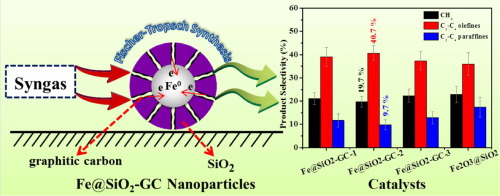Journal of Colloid and Interface Science ( IF 9.9 ) Pub Date : 2018-01-04 , DOI: 10.1016/j.jcis.2018.01.017 Zhijiang Ni , Hengfei Qin , Shifei Kang , Jirong Bai , Zhilei Wang , Yaguang Li , Zheng Zheng , Xi Li

|
Mesoporous silica-encapsulated iron materials contribute to the suppression of self-aggregation and thereby enhances the Fischer-Tropsch synthesis activity. However, constructing Fe-based supported catalysts with high activity and selectivity in the Fischer-Tropsch synthesis to lower olefins (FTO) by a conventional mesoporous silica support has been proven challenging due to its low hydrothermal stability and low reducibility. Herein, we developed a core-shell [email protected]2-GC structure with an optimized interface of the catalyst by introducing graphitic carbon (GC) that weakened the Fe-SiO2 interaction. Transmission electron microscopy and nitrogen adsorption-desorption characterization proved GC-modified catalysts had well-defined core-shell structures. The [email protected]2-GC-2 containing the optimal GC content had the largest surface area and pore volume, and outperformed Fe2O3@SiO2 in terms of CO conversion (60.1%) and C2-C4 olefin selectivity (40.7%) within 100 h. The significant improvement of FTO performance was attributed to the rigid porous framework of GC, which allowed free access of syngas and inhibited mesoporous channel collapse during FTO, so the catalytic activity and stability were improved by the synergism between higher Fe dispersion and reducibility. Moreover, the narrow well-defined mesoporous channel also exerted a modest spatial restriction effect, which inhibited the formation of long-chain hydrocarbon and tailored the product distribution toward lower distillate, thus improving the selectivity toward C2-C4.
中文翻译:

石墨碳改性对[电子邮件保护] 2 -GC催化剂通过费托合成形成低级烯烃的催化性能的影响
介孔二氧化硅包封的铁材料有助于抑制自聚集,从而提高了费-托合成活性。然而,由于费-托低的水热稳定性和低的可还原性,在费-托合成中通过常规的介孔二氧化硅载体构建具有高活性和选择性的低级烯烃(FTO)的铁基负载型催化剂已被证明是具有挑战性的。本文中,我们通过引入削弱Fe-SiO 2相互作用的石墨碳(GC),开发了具有优化的催化剂界面的核-壳[电子邮件保护] 2 -GC结构。透射电镜和氮吸附-脱附特性证明GC改性催化剂具有明确的核-壳结构。[电子邮件保护]2 -GC-2含有最佳GC含量具有最大的表面积和孔体积,以及优于铁2 ö 3 @SiO 2中的CO转化率(60.1%)和将c 2 -C 4100小时内烯烃选择性(40.7%)。FTO性能的显着改善归因于GC的刚性多孔框架,该框架允许合成气自由进入并抑制FTO期间的中孔通道塌陷,因此,较高的Fe分散度与还原性之间的协同作用提高了催化活性和稳定性。此外,狭窄的明确界定的中孔通道也发挥了适度的空间限制作用,从而抑制了长链烃的形成,并使产物分布更趋向于较低的馏出物,从而提高了对C 2 -C 4的选择性。


























 京公网安备 11010802027423号
京公网安备 11010802027423号